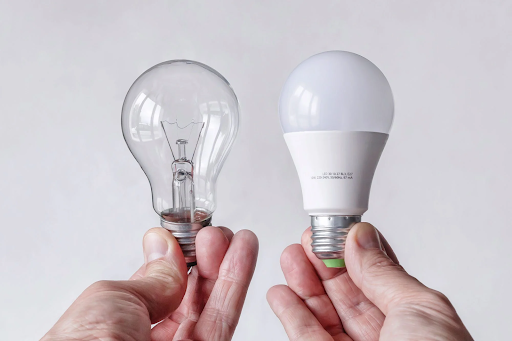Lighting is an essential aspect of any space, influencing not just visibility but also the overall ambiance and mood. With various lighting options available today, two of the most popular choices are incandescent and LED bulbs. Understanding the differences between these two technologies is crucial for making informed decisions about your lighting needs. In this blog, we will delve into the incandescent vs LED debate, exploring their efficiency, longevity, cost, and more to help you determine which option is best for your space.
The Basics: What Are Incandescent and LED Bulbs?
-
Incandescent Bulbs
Incandescent bulbs have been a staple in lighting for over a century. They work by passing electricity through a thin filament, which heats up and produces light. While these bulbs are known for their warm glow and excellent color rendering, they are increasingly seen as outdated due to their energy inefficiency.
-
LED Bulbs
Light Emitting Diodes (LEDs) represent a more modern approach to lighting. LEDs produce light through a process called electroluminescence, where electrical current passes through a semiconductor, resulting in light emission. This technology has gained immense popularity for its energy efficiency, longevity, and versatility.
Efficiency: LED vs. Incandescent
-
Energy Consumption
Incandescent bulbs are notorious for consuming more energy. On average, a standard incandescent bulb uses about 60 watts to produce around 800 lumens of light. In contrast, LED bulbs can achieve the same output with only 8 to 12 watts. This remarkable difference means that switching from incandescent to LED can lead to substantial energy savings over time.
-
Longevity
When it comes to lifespan, LED bulbs again take the lead. An incandescent bulb typically lasts about 1,000 hours, while an LED bulb can last anywhere from 15,000 to 50,000 hours, depending on the quality and brand. This longevity not only means fewer replacements but also contributes to lower overall costs in the long run.
Cost Considerations
While the initial cost of LED bulbs can be higher than incandescent ones, the long-term savings often make LEDs the more economical choice.
-
Upfront Costs
An incandescent bulb generally costs about $1, while an LED bulb may range from $5 to $15. This upfront investment can deter some consumers, but it’s essential to consider the savings over time.
-
Total Cost of Ownership
To understand the total cost of ownership, consider the energy savings and lifespan. For example, if you replace a 60-watt incandescent bulb with an 8-watt LED, you save approximately $80 over the life of the LED bulb when accounting for energy costs. This makes the higher initial investment worthwhile.
Lighting Quality
Another essential factor to consider in the LED vs incandescent efficiency discussion is the quality of light produced by each type of bulb.
-
Color Temperature
Incandescent bulbs emit a warm, yellowish light, typically around 2700K on the Kelvin scale. This warm glow is often preferred for residential settings, creating a cozy atmosphere. Conversely, LED bulbs offer a range of color temperatures, from warm white to cool daylight, allowing for more customization based on personal preferences and the specific needs of different spaces.
-
Color Rendering Index (CRI)
The Color Rendering Index (CRI) measures how accurately a light source reveals the true colors of objects. Incandescent bulbs generally have a CRI of 100, meaning they render colors very well. High-quality LED bulbs can also achieve high CRI ratings, making them suitable for tasks where color accuracy is essential, such as in art studios or photography.
Environmental Impact
The environmental footprint of lighting choices is another critical consideration.
-
Energy Use
The energy efficiency of LED bulbs means they consume significantly less power than incandescent bulbs, which translates to lower greenhouse gas emissions. As the world becomes more conscious of its environmental impact, choosing LEDs can contribute positively.
-
Waste
With their longer lifespan, LEDs also result in less waste. Fewer bulbs need to be manufactured and disposed of, reducing landfill contributions and the environmental costs associated with production.
Versatility and Options
LEDs offer a wide range of options that cater to various lighting needs and styles.
-
Design Flexibility
LED technology allows for innovative designs and fixtures that were not possible with traditional incandescent bulbs. From smart bulbs that can change colors to integrated lighting solutions, the versatility of LED lighting solutions caters to modern design aesthetics and functional requirements.
-
Dimming Capabilities
While dimming incandescent bulbs is relatively straightforward, LED dimming can sometimes be problematic with older dimmer switches. However, many LED products now come with compatible dimming features, offering the flexibility to adjust brightness while maintaining energy efficiency.
Conclusion
In the incandescent vs. LED debate, LEDs clearly emerge as the superior choice for most applications. Their energy efficiency, longevity, and versatility make them an ideal option for both residential and commercial spaces. While the initial cost may be higher, the long-term savings and environmental benefits make LED bulbs a wise investment.



